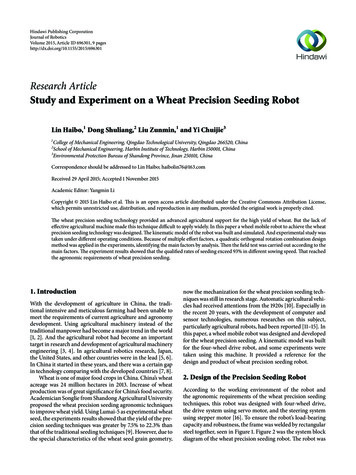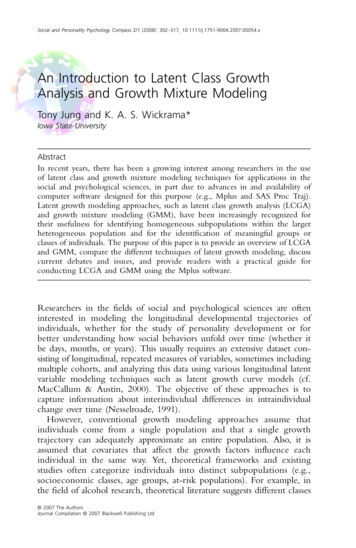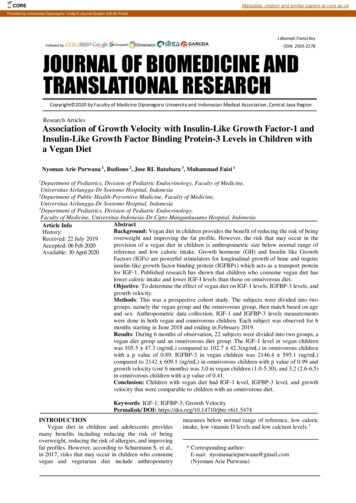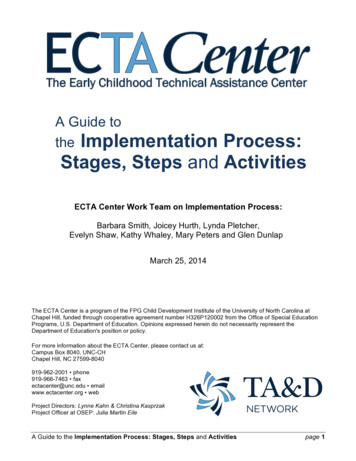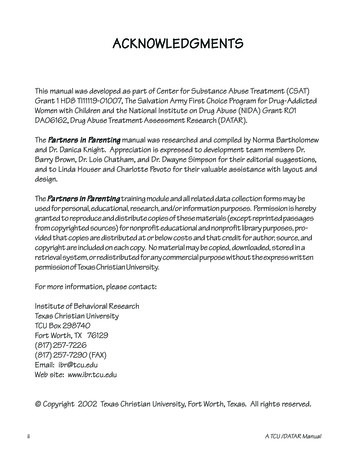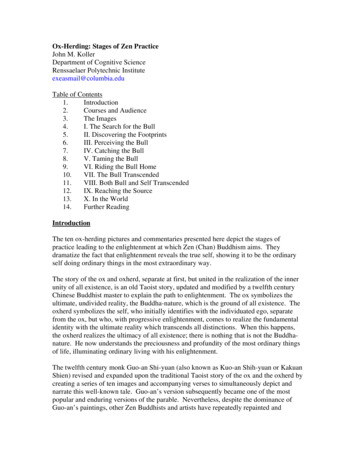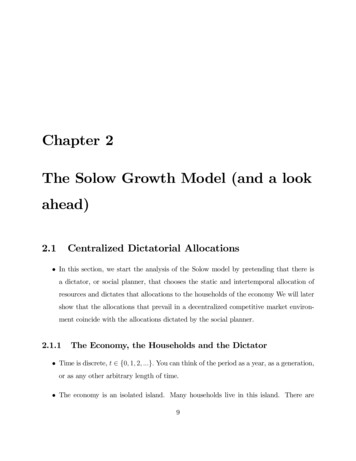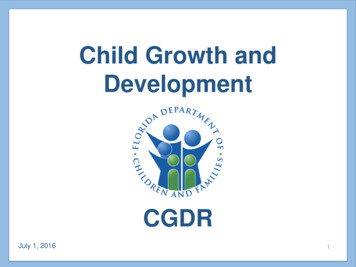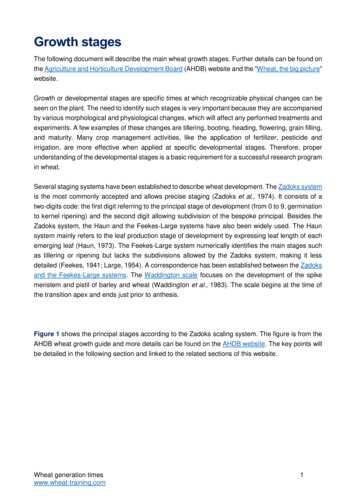
Transcription
Growth stagesThe following document will describe the main wheat growth stages. Further details can be found onthe Agriculture and Horticulture Development Board (AHDB) website and the “Wheat, the big picture”website.Growth or developmental stages are specific times at which recognizable physical changes can beseen on the plant. The need to identify such stages is very important because they are accompaniedby various morphological and physiological changes, which will affect any performed treatments andexperiments. A few examples of these changes are tillering, booting, heading, flowering, grain filling,and maturity. Many crop management activities, like the application of fertilizer, pesticide andirrigation, are more effective when applied at specific developmental stages. Therefore, properunderstanding of the developmental stages is a basic requirement for a successful research programin wheat.Several staging systems have been established to describe wheat development. The Zadoks systemis the most commonly accepted and allows precise staging (Zadoks et al., 1974). It consists of atwo-digits code: the first digit referring to the principal stage of development (from 0 to 9, germinationto kernel ripening) and the second digit allowing subdivision of the bespoke principal. Besides theZadoks system, the Haun and the Feekes-Large systems have also been widely used. The Haunsystem mainly refers to the leaf production stage of development by expressing leaf length of eachemerging leaf (Haun, 1973). The Feekes-Large system numerically identifies the main stages suchas tillering or ripening but lacks the subdivisions allowed by the Zadoks system, making it lessdetailed (Feekes, 1941; Large, 1954). A correspondence has been established between the Zadoksand the Feekes-Large systems. The Waddington scale focuses on the development of the spikemeristem and pistil of barley and wheat (Waddington et al., 1983). The scale begins at the time ofthe transition apex and ends just prior to anthesis.Figure 1 shows the principal stages according to the Zadoks scaling system. The figure is from theAHDB wheat growth guide and more details can be found on the AHDB website. The key points willbe detailed in the following section and linked to the related sections of this website.Wheat generation timeswww.wheat-training.com1
Figure 1. Illustration of the Zadoks scale system to describe wheat growth stagesSource: AHDB website http://cereals.ahdb.org.uk/Wheat generation timeswww.wheat-training.com2
a) Germination and seedling growth (GS00 to GS19)The Zadoks system starts at 0 with the germination stage (see Growing wheat), which occurs fromthe initial stage of the dry kernel to the coleoptile emergence and the first leaf formation at its tip.Then, the seedling development stage (1) takes place and is characterised by leaf formation. Aboutone leaf is produced every four to five days, usually up to nine leaves in total. One can typically startto sample leaves for DNA extraction at the three leaf stage to ensure to not remove too large aproportion of the plant (see DNA extraction protocols on 96-well plates and for high molecular DNA).Emergence date for a particular cultivar is when 50% of the seedlings have emerged. Emergencelargely depends on the depth at which the seeds are sown and also the germination energy or theamount of food reserve in the endosperm. So appropriate sowing depth and the viability of the seedare important considerations for effective seedling emergence.b) Tillering (GS20 to GS29)After the emergence of the fifth leaf additional tillers may be produced, leading to the tillering stage(2). Tillers are lateral shoots emerging at the base of the main stem of the plant (see Glossary). Eachtiller has the potential to produce a spike/ear, which is why tiller management is important regardingyield. Plants are generally potted up at the beginning of this stage (see Growing wheat). Three tillersper plant are frequently produced but certain varieties can produce more (up to nine). Everyadditional tiller represents a subdivision of the tillering stage. It is important to notice that the eardevelopment also occurs during the tillering stage and the stem starts to elongate once its formationis complete. This leads to the stem elongation stage (3).c) Stem elongation (GS30 to GS39), booting (GS40 toGS49) and heading (GS50 to GS59)Terminal spikelet (GS30) is the stage at which the final spikelet can be observed on the formingspike/ear within the stem of the main tiller. To determine terminal spikelet stage is laborious andrequires the dissection of tillers. Determination of GS31 is an alternative that can be estimated infield as the date at which the first node can be detected at approximately 1 cm above the tilleringnode, and is more easily seen with the naked eye. Every subdivision of the stem elongation stagecorresponds to the formation of a new internode before the flag leaf emergence occurs. When theflag leaf blade is completely visible, the booting stage starts (4). As the stem continues to elongate,the ear is pushed through the flag leaf sheath. The heading stage (5) begins when the ear emergesfrom the flag leaf sheath and continues until the entire ear has emerged. Wheat emasculation forcrossing purposes is usually performed during the early stages of the heading stage in order to avoidany self-pollination (see How to cross wheat). Heading date can be evaluated by counting thenumber of emerged ears within the population. For example, heading date could be recorded as thetime when 50% of the spikes have emerged from the flag leaf sheath, although one could alsoconsider 25 or 75 %.Wheat generation timeswww.wheat-training.com3
d) Flowering (GS60 to GS69)The flowering stage (6), or anthesis, begins after heading and it is at this stage that the anthersrelease their pollen. However, certain varieties can start to flower while the ear is not yet fullyemerged from the flag leaf sheath. There is a gradient in flowering time along the spike/ear of a plant,with the florets of the central spikelets flowering first. Over the next few days the spikelets above andbelow the central spikelets will flower, with the most distal florets flowering last. Once the anthersstart to release their pollen they will also begin to extrude from the florets. Thus, it is easy to detecta spike post-anthesis and estimate the flowering date. Determining the proper pollen maturity forcrossing purposes is detailed in the section How to cross wheat. The period of pollination within asingle head is about four days. Anthesis is physiologically one of the most sensitive stages and highlyaffected by temperature.e) Milk and Dough development (GS70 to GS89)Milk development stage (7) starts once the flowering is complete and is the early kernel formationstage. It is subdivided in early, medium and late milk. The developing endosperm starts as a milkyfluid that increases in solids as the milk stage progresses. Kernel size then increases rapidly duringthis stage which occurs one to two weeks after pollination. The dough development stage (8) is thestage during which most of the kernel dry weight (starch and protein content) accumulates. Harddough stage represents the attainment of maximum dry weight with approximately 30 % moisturecontent. This stage is also known as physiological maturity.f) Ripening (GS90 to GS99)Finally, the seed moisture will decrease down to 13 to 14 %. This is the ripening stage (9) and theseed may be harvested at the end of this stage (see Growing wheat).g) Generation times in the greenhouseIn general, winter wheat grown in a greenhouse requires six to eight months to finish one seed toseed cycle (including a vernalization period of 30 to 60 days). A spring variety takes three to fourmonths as it does not require vernalization (or very little). Some varieties are called facultativebecause they only need a shorter vernalization period (15 to 30 days) with temperatures varyingfrom 3 to 15 C. Recently “speed breeding”, which involves growing plants under extended daylength, has accelerated generation times (see Speed breeding).References:Zadoks, J. C., Chang, T. T. and Konzak, C. F. (1974), A decimal code for the growth stages ofcereals. Weed Research, 14: 415-421. doi: 10.1111/j.1365-3180.1974.tb01084.xHaun, J. R. (1973), Visual Quantification of Wheat Development. Agronomy Journal, 65: 116-119.Wheat generation timeswww.wheat-training.com4
doi: 10.2134/agronj1973.00021962006500010035xFeekes, W. (1941). De tarwe en haar milieu [Wheat and its environment]. Verslagen van deTechnische Tarwe Commissie. (in Dutch and English). 17: 523–888Large, E. C. (1954), Growth Stages in Cereals Illustration of the Feekes Scale. Plant Pathology, 3:128-129. doi: 10.1111/j.1365-3059.1954.tb00716.xWaddington, S. R., Cartwright, P. M. and Wall, P. C. (1983), A Quantitative Scale of Spike Initialand Pistil Development in Barley and Wheat. Annals of Botany, 51: 119–130.doi: 10.1093/oxfordjournals.aob.a086434Wheat generation timeswww.wheat-training.com5
dough stage represents the attainment of maximum dry weight with approximately 30 % moisture content. This stage is also known as physiological maturity. f) Ripening (GS90 to GS99) Finally, the seed moisture will decrease down to 13 to 14 %. This is the ripening stage (9) and the seed may be harvested at the end of this stage (see Growing wheat). g) Generation times in the greenhouse In .File Size: 360KBPage Count: 5
